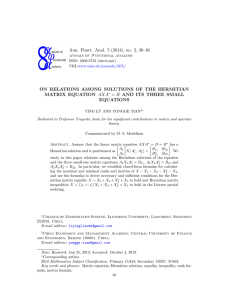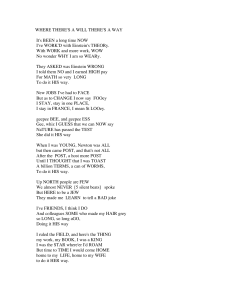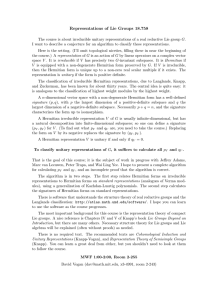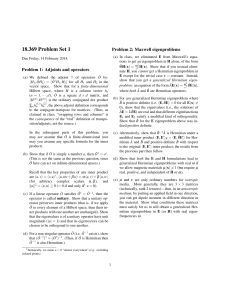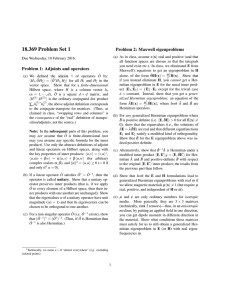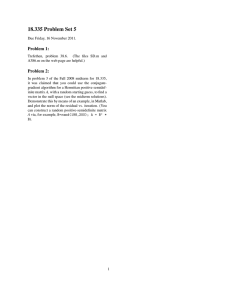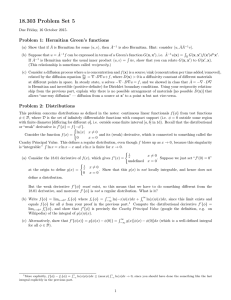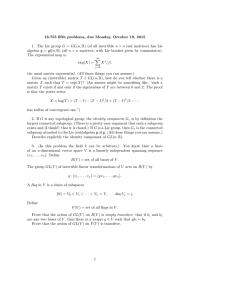Semistability of Principal Bundles on a K¨ ahler
advertisement
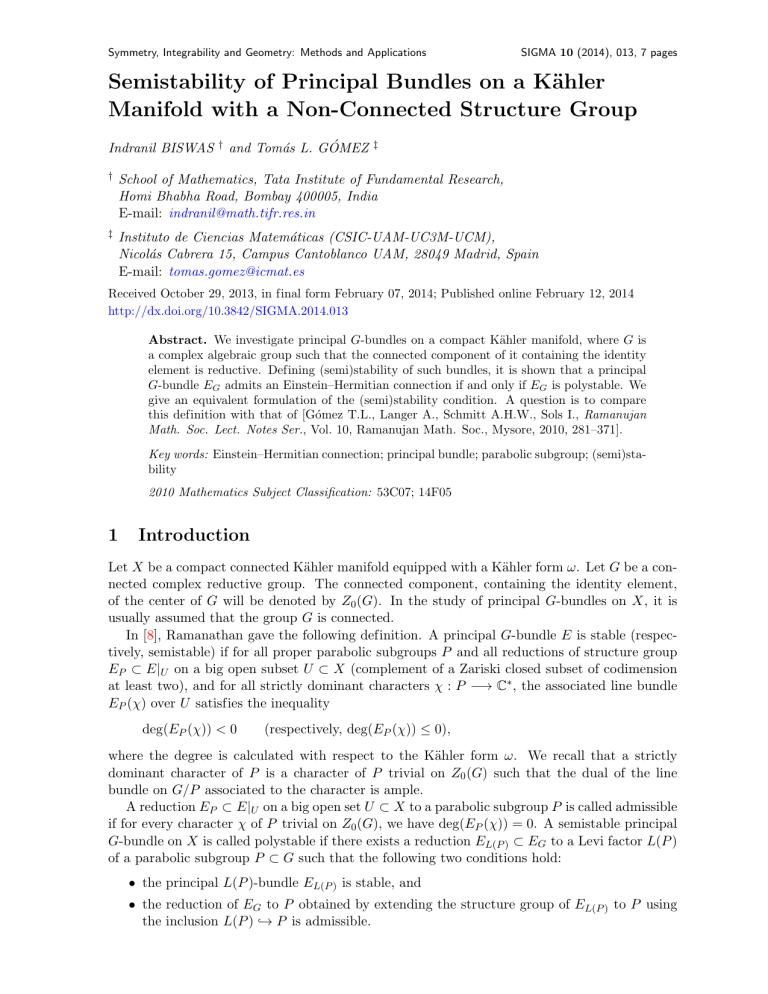
Symmetry, Integrability and Geometry: Methods and Applications SIGMA 10 (2014), 013, 7 pages Semistability of Principal Bundles on a Kähler Manifold with a Non-Connected Structure Group Indranil BISWAS † and Tomás L. GÓMEZ ‡ † School of Mathematics, Tata Institute of Fundamental Research, Homi Bhabha Road, Bombay 400005, India E-mail: indranil@math.tifr.res.in ‡ Instituto de Ciencias Matemáticas (CSIC-UAM-UC3M-UCM), Nicolás Cabrera 15, Campus Cantoblanco UAM, 28049 Madrid, Spain E-mail: tomas.gomez@icmat.es Received October 29, 2013, in final form February 07, 2014; Published online February 12, 2014 http://dx.doi.org/10.3842/SIGMA.2014.013 Abstract. We investigate principal G-bundles on a compact Kähler manifold, where G is a complex algebraic group such that the connected component of it containing the identity element is reductive. Defining (semi)stability of such bundles, it is shown that a principal G-bundle EG admits an Einstein–Hermitian connection if and only if EG is polystable. We give an equivalent formulation of the (semi)stability condition. A question is to compare this definition with that of [Gómez T.L., Langer A., Schmitt A.H.W., Sols I., Ramanujan Math. Soc. Lect. Notes Ser., Vol. 10, Ramanujan Math. Soc., Mysore, 2010, 281–371]. Key words: Einstein–Hermitian connection; principal bundle; parabolic subgroup; (semi)stability 2010 Mathematics Subject Classification: 53C07; 14F05 1 Introduction Let X be a compact connected Kähler manifold equipped with a Kähler form ω. Let G be a connected complex reductive group. The connected component, containing the identity element, of the center of G will be denoted by Z0 (G). In the study of principal G-bundles on X, it is usually assumed that the group G is connected. In [8], Ramanathan gave the following definition. A principal G-bundle E is stable (respectively, semistable) if for all proper parabolic subgroups P and all reductions of structure group EP ⊂ E|U on a big open subset U ⊂ X (complement of a Zariski closed subset of codimension at least two), and for all strictly dominant characters χ : P −→ C∗ , the associated line bundle EP (χ) over U satisfies the inequality deg(EP (χ)) < 0 (respectively, deg(EP (χ)) ≤ 0), where the degree is calculated with respect to the Kähler form ω. We recall that a strictly dominant character of P is a character of P trivial on Z0 (G) such that the dual of the line bundle on G/P associated to the character is ample. A reduction EP ⊂ E|U on a big open set U ⊂ X to a parabolic subgroup P is called admissible if for every character χ of P trivial on Z0 (G), we have deg(EP (χ)) = 0. A semistable principal G-bundle on X is called polystable if there exists a reduction EL(P ) ⊂ EG to a Levi factor L(P ) of a parabolic subgroup P ⊂ G such that the following two conditions hold: • the principal L(P )-bundle EL(P ) is stable, and • the reduction of EG to P obtained by extending the structure group of EL(P ) to P using the inclusion L(P ) ,→ P is admissible. 2 I. Biswas and T.L. Gómez Ramanathan used this notion in [9, 10] to construct the moduli space of semistable principal bundles when dim X = 1. In [11] Ramanathan and Subramanian proved that a principal Gbundle admits an Einstein–Hermitian connection if and only if it is polystable. Behrend defined stability for group schemes in [3]. A reductive group scheme G/X on X is stable (respectively, semistable) if for all parabolic subgroup schemes P/X, we have deg(P/X) := deg(ad(P)) < 0 (respectively, deg(ad(P)) ≤ 0), where ad(P) is the associated Lie algebra bundle on X. Then he defines a principal G-bundle on X to be stable (respectively, semistable) if the associated group scheme Ad(E) is semistable (respectively, semistable). If G is connected, then it is easy to see that Behrend’s definition of stability coincides with Ramanathan’s, because the normalizer NG (P ) of a parabolic subgroup P in G is equal to P when G is connected. If G is reductive but not connected, the moduli space of principal G-bundles has been constructed in [5] for projective varieties. Given a 1-parameter subgroup λ : C∗ −→ [G, G] ⊂ G, a parabolic subgroup P (λ) is defined as follows [12] P (λ) = g ∈ G : lim λ(t)gλ(t)−1 exists in G (1) t→∞ and the condition of stability is checked only with these parabolic subgroups. The construction in [5] is done using Geometric Invariant Theory, and one obtains a stability condition involving Hilbert polynomials. Looking only at the leading coefficients one obtains the associated “slope” stability, as usual, which only involves degrees. This is the stability we consider, since this is the one which is expected to correspond to the existence of Einstein–Hermitian connections. Here we address the problem of finding a condition for the existence of an Einstein–Hermitian connection on a principal G-bundle on X when G is not connected. If G0 is the connected component of identity of G, then E −→ E/G0 is a principal G0 -bundle on Y := E/G0 , and Y is a finite étale cover of X. In Section 2 we define the principal G-bundle E to be polystable when the principal G0 -bundle E −→ Y is polystable (cf. Definition 1), and prove that this is a necessary and sufficient condition for the existence of an Einstein–Hermitian connection on E. In Section 3 we show that this definition of polystability is equivalent to checking the usual condition for those parabolic subgroups of G of the form NG (p), where p is a parabolic subalgebra of the Lie algebra g of G. Note that NG (Lie(P )) = NG (P 0 ) for any parabolic subgroup P , where Lie(P ) is the Lie algebra and P 0 is the connected component of P containing the identity element. We remark that, if G is connected, all parabolic subgroups are of this form because for a connected reductive group, NG (p) = NG (P ) = P . It is natural to ask whether our condition is equivalent to the condition in [5] in terms of 1-parameter subgroups. For any parabolic subgroup P , it is P ⊂ NG (Lie(P )). Hence, a reduction of structure group to P gives reduction to NG (Lie(P )), and therefore if a principal G-bundle is (semi)stable in the sense of [5], then it is also (semi)stable in our sense. The implication in the other direction is not clear, since there exist examples of non-connected groups G and 1-parameter subgroups λ such that NG (P (λ)0 ) is strictly larger than P (λ). It would be interesting to be able to compare the two definitions. 2 2.1 Connections on principal bundles Semistable and polystable bundles Let G be a reductive linear algebraic group defined over C. We do not assume that G is connected. Let G0 ⊂ G be the connected component containing the identity element. We note Principal Bundles with a Non-Connected Structure Group 3 that G0 is a normal subgroup of G. The quotient group Γ := G/G0 (2) parametrizes the connected components of G. Let X be a compact connected Kähler manifold equipped with a Kähler form ω. Let EG −→ X be a holomorphic principal G-bundle on X. Consider the quotient map φ EG −→ EG /G0 =: Y. (3) The natural projection f : Y −→ X (4) is a unramified Galois covering map with Galois group Γ (defined in (2)). The pulled back form f ∗ ω is a Kähler form on Y . It should be clarified that Y need not be connected. The projection φ in (3) makes EG a holomorphic principal G0 -bundle on Y . Definition 1. The principal G-bundle EG on X is called semistable (respectively, stable) if for each connected component Y 0 of Y , the principal G0 -bundle φ−1 (Y 0 ) −→ Y 0 is semistable (respectively, stable). Similarly, EG on X is called polystable if the principal G0 bundle φ−1 (Y 0 ) −→ Y 0 is polystable for every connected component Y 0 of Y . Lemma 1. A principal G-bundle EG on X is semistable (respectively, polystable) if for some connected component Y 0 of Y , the principal G0 -bundle φ−1 (Y 0 ) −→ Y 0 is semistable (respectively, polystable). The same criterion holds for stability. Proof . Take two connected components Y1 and Y2 of Y . Since the covering map f in (4) is Galois, there is an element g of the Galois group such that the automorphism g of Y takes Y1 to Y2 . Let ge := g|Y1 : Y1 −→ Y2 be this isomorphism. Let E1 (respectively, E2 ) be the restriction of the principal G0 -bundle EG −→ Y to Y1 (respectively, Y2 ). Since f ◦ ge = f , and Lie(G) = Lie(G0 ), we have ge∗ ad(E2 ) = ad(E1 ). (5) On the other hand, a principal G0 -bundle is semistable (respectively, polystable) if and only if the corresponding adjoint vector bundle is semistable (respectively, polystable); see [1, p. 214, Proposition 2.10] and [1, p. 224, Corollary 3.8]. Therefore, from (5) we conclude that E1 is semistable (respectively, polystable) if and only if E2 is semistable (respectively, polystable). This isomorphism in (5) is compatible with the Lie algebra structure of the fibers of the two adjoint bundles. We recall that a principal G0 -bundle FG0 is stable if for every parabolic subalgebra bundle e p ⊂ ad(FG0 ), we have degree(e p) < 0 (see [3]). Therefore, if E1 is stable, then E2 is also stable. 4 2.2 I. Biswas and T.L. Gómez Einstein–Hermitian connections Any two maximal compact subgroups of G differ by an inner automorphism of G. Fix a maximal compact subgroup K ⊂ G. The quotient G/K is a contractible manifold, in particular, G/K is connected. Take a holomorphic principal G-bundle EG over X. A Hermitian structure on EG is a C ∞ reduction of structure group of EG to K. Since G/K is contractible, and any C ∞ fiber bundle with a contractible fiber is trivial, it follows immediately that EG admits Hermitian structures. Any two connections on the principal G-bundle EG differ by a smooth 1-form with values in ad(EG ). Two C ∞ connections ∇1 and ∇2 on the principal G-bundle EG are called equivalent if ∇1 − ∇2 is of type (1, 0) [7, p. 87]. The complex structure on the total space of EG defines an equivalence class of connections on EG [7, p. 87, Proposition 2]. Let EK ⊂ EG be a Hermitian structure. Then there is a unique connection ∇ on the principal e on EG induced by ∇ lies in the equivalence class of K-bundle EK such that the connection ∇ e is connections defined by the complex structure on EG [2, pp. 191–192, Proposition 5]. This ∇ called the Chern connection corresponding to EK . Let ad(EK ) −→ X be the adjoint vector bundle for the principal K-bundle EK . Let K(∇) ∈ Ω1,1 (ad(EK )) be the curvature of the above connection ∇ on EK . The Hermitian structure EK is called Einstein–Hermitian if the section Λω K(∇) ∈ Ω0 (ad(EK )) is given by some element of the center of the Lie algebra of K; here Λω is the adjoint of multiplication of differential forms by the Kähler form ω. Theorem 1. A holomorphic principal G-bundle EG on X admits an Einstein–Hermitian structure if and only if EG is polystable. Given a polystable principal G-bundle EG over X, the Chern connection on EG corresponding to a Einstein–Hermitian structure on EG is independent of the choice of Einstein–Hermitian structure. Proof . First assume that EG −→ X admits an Einstein–Hermitian structure. The connection on the adjoint vector bundle ad(EG ) induced by an Einstein–Hermitian connection on EG is also Einstein–Hermitian. Therefore, ad(EG ) is polystable. Take any connected component Y 0 of Y . Let f be the restriction of f to Y 0 . Let E 0 −→ Y 0 be the principal G0 -bundle obtained by restricting EG −→ Y to Y 0 . ∗ Since f ad(EG ) = ad(E 0 ), and ad(EG ) is polystable, we conclude that ad(E 0 ) is polystable [4, p. 439, Proposition 2.3]. Hence E 0 is polystable [1, p. 224, Corollary 3.8]. To prove the converse, assume that the principal G0 -bundle EG −→ X is polystable. Take a connected component Y 0 of Y . As before, f is the restriction of f to Y 0 , and E 0 −→ Y 0 is the principal G0 -bundle obtained by restricting EG −→ Y to Y 0 . The adjoint vector bundle ad(E 0 ) is polystable because E 0 is polystable. Since f is an étale covering map, an Einstein–Hermitian connection on ad(E 0 ) produces an Einstein–Hermitian connection on the direct image f ∗ ad(E 0 ). We note that this uses the fact that the Kähler form on Y 0 is the pullback of the Kähler form on X. Since f ∗ ad(E 0 ) admits an Einstein–Hermitian connection, it follows that f ∗ ad(E 0 ) is polystable. Since ad(EG ) is a direct summand of f ∗ ad(E 0 ), we conclude that ad(EG ) is polystable. The Einstein–Hermitian connection on f ∗ ad(E 0 ) preserves ad(EG ), because ad(EG ) is a direct summand of f ∗ ad(E 0 ). The connection ∇ on ad(EG ) obtained this way is Einstein–Hermitian. Principal Bundles with a Non-Connected Structure Group 5 Take the Einstein–Hermitian connection on ad(E 0 ) to be one given by an Einstein–Hermitian connection on E 0 . Therefore, the Einstein–Hermitian connection on ad(E 0 ) is compatible with the Lie algebra structure of the fibers of ad(E 0 ). This implies that the above connection ∇ on ad(EG ) is compatible with the Lie algebra structure of the fibers of ad(EG ). Therefore, ∇ defines a connection on the principal Aut(Lie(G))-bundle EAut(Lie(G)) = EG ×G Aut(Lie(G)) associated to EG for the homomorphism G −→ Aut(Lie(G)) given by the adjoint action of G on Lie(G). This connection on EAut(Lie(G)) given by ∇ will be denoted by ∇0 . This connection ∇0 is Einstein–Hermitian because ∇ is so. Define Gab := G/[G, G]. The quotient homomorphism G −→ Gab will be denoted by q. Let ab be the connected component containing the identity element. Let Gab 0 ⊂G β : Gab −→ Gab be the homomorphism defined by z 7−→ z n , where n is the order of the quotient group Gab /Gab 0 . ab ab Note that β(G0 ) = G0 , and the homomorphism ab ab Gab /Gab 0 −→ G /G0 given by β is the trivial homomorphism. Hence β(Gab ) = Gab 0 . Define γ := β ◦ q : G −→ Gab 0 . ab on X obtained by extending the structure Since Gab 0 is a torus, the principal G0 -bundle EGab 0 group of EG using γ has a unique Einstein–Hermitian connection. We will denote this Einstein– Hermitian connection on EGab by ∇0 . 0 The connection ∇0 (respectively, ∇0 ) is a 1-form on the total space EAut(Lie(G)) (respectively, EGab ) with values in the Lie algebra Lie(Aut(Lie(G))) (respectively, Lie(Gab 0 )). Using the 0 natural map EG −→ EAut(Lie(G)) (respectively, EG −→ EGab ), the 1-form ∇0 (respectively, ∇0 ) 0 pulls back to a 1-form on EG with values in Lie(Aut(Lie(G))) (respectively, Lie(Gab 0 )); this 0 c b 1-form on EG will be denoted by ∇ (respectively, ∇ ). Note that Lie(G) = Lie(Aut(Lie(G))) ⊕ Lie Gab 0 . c0 is a 1-form on EG with values in the Lie algebra Lie(G). It is straightforward b +∇ Therefore, ∇ c0 defines a connection on EG . This connection b +∇ to check that this Lie(G)-valued 1-form ∇ e on EG will be denoted by ∇. Fix a point x0 ∈ X. Let Aut((EG )x0 ) denote the group of automorphisms of (EG )x0 that commute with the action of G on (EG )x0 . Note that Aut((EG )x0 ) is identified with the fiber of the adjoint bundle Ad(EG )x0 , and it is isomorphic to G. Consider parallel translations of e These the fiber (EG )x0 , along loops based at x0 , with respect to the above connection ∇. together produce a subgroup of Aut((EG )x0 ). It can be shown that this subgroup is contained in a compact subgroup of Aut((EG )x0 ). Indeed, this follows from the fact that the holonomies of both ∇0 and ∇0 are compact. Therefore, possibly taking an extension of structure group, we get a Hermitian structure on EG . (The above subgroup of Aut((EG )x0 ) is a conjugate of a subgroup of K.) This Hermitian structure is Einstein–Hermitian because both ∇0 and ∇0 are so. An Einstein–Hermitian connection on the principal G-bundle EG −→ X pulls back to an Einstein–Hermitian connection on the principal G0 -bundle E 0 −→ Y 0 . Therefore, the uniqueness of the Einstein–Hermitian connection on EG follows from the uniqueness of the Einstein– Hermitian connection on E 0 . To explain this, from [11, p. 24, Theorem 1] we know that a stable 6 I. Biswas and T.L. Gómez bundle has a unique Einstein–Hermitian connection, and from [6, p. 111, Theorem 3.27] we know that for any decomposition of a polystable vector bundle F into a direct sum of stable vector bundles, each direct summand is preserved by any Einstein–Hermitian connection on F . Now apply this to the adjoint vector bundle ad(E 0 ) and the principal G0 /[G0 , G0 ]-bundle associated to E 0 . 3 Equivalence of stability conditions For a parabolic subalgebra p of Lie(G), by NG (p) we will denote the subgroup of G that preserves p by the adjoint action. In this section, by a parabolic subgroup of G we will mean a group of the form NG (p) for some parabolic subalgebra p. As before, by Z0 (G) we will denote the connected component of the center of G containing the identity element. Definition 2. A principal G-bundle is called adjoint semistable (respectively, adjoint stable) if for all reductions to a proper parabolic subgroup P , and all reductions of structure group EP ⊂ E|U on a big open subset U ⊂ X, and for all strictly dominant characters χ : P −→ C∗ , the associated line bundle EP (χ) satisfies deg(EP (χ)) < 0 (respectively, deg(EP (χ)) ≤ 0), where the degree is calculated with respect to the Kähler form ω. T A character of P is called dominant if the restriction to P0 := P G0 is dominant. Recall that a reduction EP ⊂ E|U on a big open set U ⊂ X to a parabolic subgroup P is called admissible if for every nontrivial character χ of P trivial on Z0 (G), we have deg(EP (χ)) = 0. A semistable principal G-bundle on X is called adjoint polystable if there exists a reduction EL(P ) ⊂ EG to a Levi factor L(P ) of a parabolic subgroup P ⊂ G such that the following two conditions hold: • the principal L(P )-bundle EL(P ) is stable, and • the reduction of EG to P obtained by extending the structure group of EL(P ) to P is admissible. Lemma 2. A principal G-bundle E on X is adjoint semistable if and only if it is semistable in the sense of Definition 1. Proof . Recall that a principal G-bundle E on X induces a principal G0 -bundle E0 on Y =E/G0 . By Definition 1, a principal G-bundle E is semistable if and only if the restriction of E0 to a connected component Y 0 of Y is semistable. This is equivalent to ad(E0 ) being semistable (cf. [1, p. 214, Proposition 2.10]). Note that ad(E0 ) is isomorphic to f ∗ ad(E), which is Γ-equivariant. If ad(E0 ) is semistable, the it is also equivariantly semistable. On the other hand, suppose that it is unstable. Its Harder– Narasimhan filtration is unique, so it will be equivariant, and hence ad(E0 ) will be equivariantly unstable. Therefore, ad(E0 ) is semistable if and only if it is equivariantly semistable. Taking the quotient by Γ, this is equivalent to the vector bundle ad(E) on X being semistable. We remark that the proof of [1, p. 214, Proposition 2.10] also works for disconnected groups if we use Definition 2. So ad(E) is semistable if and only if E is adjoint semistable. Lemma 3. A principal G-bundle E on X is adjoint polystable if and only if it is polystable in the sense of Definition 1. Principal Bundles with a Non-Connected Structure Group 7 Proof . If E is polystable in the sense of Definition 1, then from Theorem 1 it follows that the adjoint vector bundle ad(E) is polystable. Conversely, if ad(E) is polystable, then f ∗ ad(E) is polystable because an Einstein–Hermitian connection on ad(E) pulls back to an Einstein– Hermitian connection on f ∗ ad(E). If f ∗ ad(E) is polystable, from [1, p. 224, Corollary 3.8] we know that E is polystable in the sense of Definition 1. On the other hand, ad(E) is polystable if and only if E is adjoint polystable; its proof is identical to the proof of [1, p. 224, Corollary 3.8]. Acknowledgements We would like to thank B. Conrad and A. Nair for discussions. The first-named author acknowledges the support of the J.C. Bose Fellowship. The second-named author thanks the Tata Institute of Fundamental Research for the hospitality during a visit where part of this work was done. This work was partly funded by the grant MTM2010-17389 and ICMAT Severo Ochoa project SEV-2011-0087 of the Spanish Ministerio de Economı́a y Competitividad. References [1] Anchouche B., Biswas I., Einstein–Hermitian connections on polystable principal bundles over a compact Kähler manifold, Amer. J. Math. 123 (2001), 207–228. [2] Atiyah M.F., Complex analytic connections in fibre bundles, Trans. Amer. Math. Soc. 85 (1957), 181–207. [3] Behrend K.A., Semi-stability of reductive group schemes over curves, Math. Ann. 301 (1995), 281–305. [4] Biswas I., Subramanian S., Semistability and finite maps, Arch. Math. (Basel) 93 (2009), 437–443. [5] Gómez T.L., Langer A., Schmitt A.H.W., Sols I., Moduli spaces for principal bundles in large characteristic, in Teichmüller Theory and Moduli Problem, Ramanujan Math. Soc. Lect. Notes Ser., Vol. 10, Ramanujan Math. Soc., Mysore, 2010, 281–371, math.AG/0506511. [6] Kobayashi S., Differential geometry of complex vector bundles, Publications of the Mathematical Society of Japan, Vol. 15, Princeton University Press, Princeton, NJ, 1987. [7] Koszul J.L., Lectures on fibre bundles and differential geometry, Tata Institute of Fundamental Research Lectures on Mathematics, Vol. 20, Tata Institute of Fundamental Research, Bombay, 1960, available at http://www.math.tifr.res.in/~publ/ln/tifr20.pdf. [8] Ramanathan A., Moduli for principal bundles, in Algebraic Geometry (Proc. Summer Meeting, Univ. Copenhagen, Copenhagen, 1978), Lecture Notes in Math., Vol. 732, Springer, Berlin, 1979, 527–533. [9] Ramanathan A., Moduli for principal bundles over algebraic curves. I, Proc. Indian Acad. Sci. Math. Sci. 106 (1996), 301–328. [10] Ramanathan A., Moduli for principal bundles over algebraic curves. II, Proc. Indian Acad. Sci. Math. Sci. 106 (1996), 421–449. [11] Ramanathan A., Subramanian S., Einstein–Hermitian connections on principal bundles and stability, J. Reine Angew. Math. 390 (1988), 21–31. [12] Springer T.A., Linear algebraic groups, Progress in Mathematics, Vol. 9, 2nd ed., Birkhäuser Boston Inc., Boston, MA, 1998.
